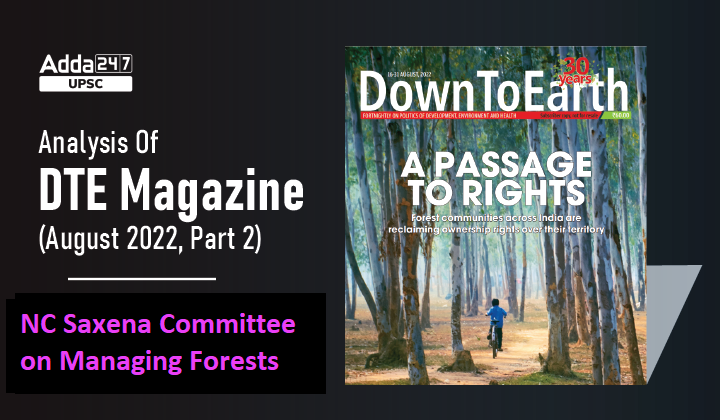Table of Contents
Down To Earth Magazine is a fortnightly magazine focusing on politics of environment and development, published in New Delhi, India.
UPSC Previous years’ questions on Development, Environment, Health and Disaster Management give us a clear idea about the increased importance of Down To Earth Magazine.
Down To Earth Magazine is one of the most important and indispensable sources for UPSC Civil Services Exam Preparation.
Keeping this in mind, here, we come with ”Gist Of Down To Earth Magazine” which covers important environmental current affairs articles in smooth pointed form, keeping in mind the demand of UPSC aspirants.
NC Saxena Committee on Managing Forests: Why in news?
- An estimated 15 per cent of global forests are managed as community resources by indigenous peoples and local communities states “Sustainable Use of Wildlife” report released last month at the ninth session of the Plenary of the Intergovernmental Science-Policy Platform on Biodiversity and Ecosystem Services (IPBES-9).
- Indigenous peoples manage over 38 million sq km in 87 countries. This is 40 per cent of terrestrial conserved areas with high biodiversity value.
- Globally, deforestation is generally lower on indigenous territories where there is a security of land tenure and continuity of traditional knowledge.
NC Saxena Committee on Managing Forests: Background
- In February 2020, the Union Ministry of Tribal Affairs (mota) set up a committee headed by a former secretary to the Union government, N C Saxena, to recommend guidelines on the use of community forest resources.
- In November 2021, the committee submitted its recommendations and asked the ministry to re-lease the report for public opinion.
NC Saxena Committee on Managing Forests: What is JFM?
- Under JFM, communities and forest departments take up the regeneration and management of forests together.
- A Joint Forest Management Committee (JFMC), comprising members of the tribal and forest-dwelling community and forest officials, is the nodal body.
- But experience of last three decades (the JFM system came into being with the National Forest Policy of 1988) shows that communities have not had any significant management role.
- Though the committees are headed by forest dwellers, the secretary is always from the forest department and manages the records as well as the day-to-day running of the body.
- In a few states the economic returns, even after decades of protection, are negligible. The community members usually get usufruct rights like the collection of fuel wood and limited grazing access along with a share in the timber to be harvested in the protected areas.
- The recognition of Community Forest Resource Rights (CFRR) across states means an end to the Joint Forest Management (JFM) system.
NC Saxena Committee on Managing Forests: Key Recommendations
- The committee puts the gram sabha at the core of CFRR management, with the power to take all decisions.
- It says the gram sabha should constitute the Forest Rights Committee (FRC) that will play a vital role in identifying community forest resources and hence the territorial jurisdiction of the gram sabha and its decisions with regard to the identification of community forest resources shall be binding.
- It also recommends that the territorial jurisdiction of the gram sabha should be in accordance with the boundaries of the community forest resources as determined by frc and that these boundaries be defined prior to the recognition of all forest rights.
- The recommendations add that while forest resources other than minor forest produce, like timber, will not fall under the territorial jurisdiction of the gram sabha they should be managed by the forest department in consultation with the gram sabha.
- It further said that in areas covered under 3(1)(i), the role of the forest department should be that of an expert and/or technical advisor, as and when such advice is sought.
NC Saxena Committee on Managing Forests: Preemptive Actions
- Since the recommendations are yet to be accepted, state governments keep issuing orders that often dilute the power of forest communities and impose government control.
- Some state governments have issued orders to make a village level committee whose job would be to finalise or reject CFMC’s proposal. Basically, its a government watchdog over an independent committee.
- On July 6, 2021, mota and moefcc signed a “Joint Communication” for more effective implementation of FRA. It says the state forest department should “extend assistance to the institutions/committees for preparing conservation and management plan for forest resources”.
NC Saxena Committee on Managing Forests: Doubts on Forest Conservation Rules, 2022
- In its new Forest Conservation Rules, 2022, notified on June 28, moefcc seems to be diluting the gram sabha’s powers to prevent diversion of forestland for non-forest purposes, which could include any development activity.
- Earlier, a developer had to approach the Central government for Stage 1 clearance for any project on forest land. It then had to seek the permission of the concerned gram sabhas before going to the state government for Stage 2 clearance.
- But the Forest Conservation Rules 2022 have no mention of gram sabha’s consent, and the developer can directly approach the state/Union Territory administration for Stage II clearance, says Kanchi Kohli, a legal researcher at the Centre for Policy Research, Delhi.
- The compliance with fra has been left to the state, after the clearance by the Centre has already been given. In other words, the Centre has left the states to do the fighting with the people.
NC Saxena Committee on Managing Forests: Way Forward
- The world is talking about the rights of indigenous people and their vital role in conservation.
- From a conservation point of view, FRA 2006 is the only conservation Act, while the Forest (Conservation) Act, 1980 is just a tool to find ways to legalise and systematise forest destruction. If control comes under forest communities, it will accelerate conservation and regeneration of forests. We should make efforts to move in this direction.



 TSPSC Group 1 Question Paper 2024, Downl...
TSPSC Group 1 Question Paper 2024, Downl...
 TSPSC Group 1 Answer key 2024 Out, Downl...
TSPSC Group 1 Answer key 2024 Out, Downl...
 UPSC Prelims 2024 Question Paper, Downlo...
UPSC Prelims 2024 Question Paper, Downlo...





